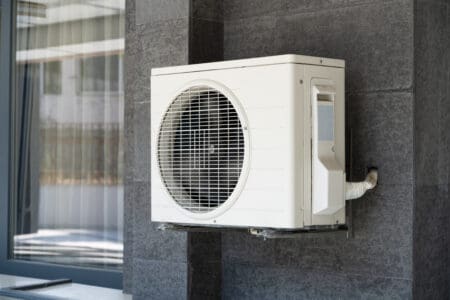A heat pump is an HVAC system that exchanges heat energy from one medium to another. It does this via refrigerant, similar to an air conditioner, but it has a reversing valve that allows for heating, too. There’s a wide range of heat pump configurations on the market. Let’s explore the maintenance requirements for the most common setup used for residential purposes. That’s a ducted air-source heat pump (ASHP), which requires seasonal maintenance in spring and again in the fall.
HVAC Disconnect Switch
A disconnect switch is a code requirement for all modern HVAC systems. It provides a convenient access point outside the home through which you can quickly and easily disable the entire system. Each season, your technician will clean the switch and ensure that it’s seated properly and in good condition. Disconnect switches don’t fail often, but when they do, they prevent power to the entire system.
Outdoor Unit Housing
All heat pumps have an outdoor unit. The enclosure may trap leaves and other debris over time. You should blow it out every season at least and, ideally, check it each month. Keep the enclosure’s exterior relatively clean and tighten screws that can vibrate loose as needed. You should also maintain a perimeter around the enclosure to keep the condenser coil as clean as possible. The perimeter should be 18 to 24 inches and free of overhanging branches, bushes, grass, and so forth.
Refrigerant Lines
The refrigerant lines extend from the outdoor unit to the indoor unit. It’s important to check these lines visually and tighten all connections. There’s also an expansion valve that your technician must clean and inspect. If everything looks good, the next step is to check the refrigerant pressure or level. Heat pumps don’t use up refrigerant. If the system is working well, the refrigerant should be at an expected pressure. If it’s not, then the system has a leak. You must diagnose and fix the leak and refill the refrigerant to the appropriate level.
Condenser Coil
The condenser coil is in the outdoor unit. The fan draws air over the coil to facilitate the transfer of heat energy. Over time, the coil accumulates dirt and other particles on it. That buildup makes the transfer of heat energy less efficient, which causes your electricity costs to rise. You can clean it with a garden hose using a light setting and spraying left to right. During your seasonal appointment, your technician will use a chemical coil cleaner to remove the most stubborn grime.
Condenser Pump
The condenser pump is an integral component of any heat pump or AC unit because it pressurizes the refrigerant. This is a major component that will malfunction or fail over time, so routine maintenance is pivotal. Pump maintenance requires a professional, as you need to remove it from the system in order to clean and lubricate it. You must also check the packing, alignment, and mounting.
Condenser Fan
Check the fan blades to ensure that they’re intact and reasonably clean. You also need to clean the condenser fan motor, grease the motor bearing, and add oil via the motor oil ports. Test the fan capacitor, and be sure to replace it as needed.
Reversing Valve
The reversing valve is the main component that separates a heat pump from an AC unit. Your technician needs to inspect the valve and clean the capillaries. The most common issue is that the reversing valve gets stuck, and your technician will free it up. In some cases, it gets stuck because there’s a refrigerant leak or the solenoid is bad, so you need to replace it.
Blower
Your technician will break down the entire air handler and rebuild it. This allows for a thorough inspection and testing of the wires, electrical components, and the blower itself. The blower motor requires thorough cleaning. You also have to grease the bearing and add oil to the motor. Your technician will check the fan blades and the balance of the system and adjust it as needed.
Evaporator Coil
The evaporator coil is another key component of any air conditioner or heat pump. It cools the air that the blower forces over it. Each spring, your technician will use coil cleaner to remove any dirt or growth from the coils. That accumulation can significantly affect the energy efficiency of the system. In the case of growth, it can negatively affect the indoor air quality as well.
Condensate Drainage
The evaporator coil creates condensation as a byproduct of cooling the air. There are three core components of drainage that you must inspect and clean: the drip pan, wet switch, and condensate drain line. The drip pan collects moisture that drips down from the coil. Ensure it’s clean and free of significant imperfections. The wet switch trips the system if the drip pan were to overflow. Test it and replace as needed. You need to clean the condensate drain line with a vacuum. If there’s a blockage, you may need to use vinegar, bleach, and water or even a chemical condensate drain line cleaner.
HVAC Filter
A ducted ASHP will have at least one supply vent that requires an air filter. This is a good time to check the filter and replace it if needed. You should also consider the filter’s rating. Most modern systems support up to a MERV 13 filter. Using a high-quality filter can better protect the system and improve your indoor air quality. This is also a good time to clean the return vents. Clean the vent, the underside, and up into the duct as far as you can reach. If you notice excessive buildup in there, then it may be time to schedule a duct cleaning.
Thermostat
Remove the face of the thermostat and use a light brush to clean the contacts. Corrosion isn’t common, but if you have that issue, clean it and replace the batteries. Severe corrosion may require a unit replacement. Use a separate thermometer to verify the thermostat temperature reading.
Static Air Pressure
Once you’ve cleaned and inspected the system, it’s time to run it and ensure that all is in working order. Your technician will check the circuit breaker, start the system, and listen for any loud noises or excessive vibration. If all sounds good, then the final step is to test the static air pressure. It has to be in the right range for that particular air handler. To do this, you need a water column manometer. You then test pressure at the supply side and return side. If the numbers are right, your heat pump is now ready for winter or summer. If not, there may be an obstruction in the ducts or another airflow issue.
Heat Pump Maintenance in Metuchen
First Choice Plumbing, Heating & Air Conditioning provides maintenance for heat pumps and all other heating and cooling systems throughout Metuchen and the neighboring communities. Our team also installs and repairs air conditioners, heat pumps, furnaces, boilers, ductless mini-splits, whole-house fans, air purifiers, dehumidifiers, and humidifiers.
We have plumbers who repipe and perform repairs as well. Our plumbers can even install fixtures, water heaters, water treatment systems, garbage disposals, and sump pumps. Call us today to learn more about our services or to schedule an appointment.




